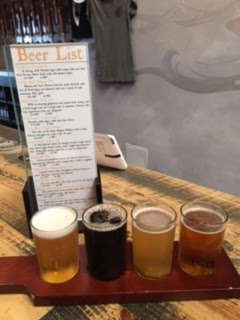
After a half day or so of driving north through Joshua Tree National Park, I was nearly at the end of the road. I had decided that my final destination was going to be Hidden Valley, which promised to give me a good look at the unique granite formations and the Joshua Trees that are the hallmark of the Mojave side of the park. Here’s the description of the trail, from the Best Easy Day Hikes book (book linked below):
- Hidden Valley – For good reason this is one of the park’s most heavily visited trails. The enchanting valley is surrounded by mounds of monzogranite and attracts climbers as well as more casual explorers.
 Except for the little side trip to the rock arch, none of
the walks I had taken in this park could be classified as hikes. Even this one, which was about a mile long
and took around a half mile, was on an easy trail over granite and sand, with a
few stone stairways thrown in where the slight elevation required it. Still, I managed to “hike” two or three miles
out there in the desert heat – and that heat was definitely the reason I took
it so easy!
Except for the little side trip to the rock arch, none of
the walks I had taken in this park could be classified as hikes. Even this one, which was about a mile long
and took around a half mile, was on an easy trail over granite and sand, with a
few stone stairways thrown in where the slight elevation required it. Still, I managed to “hike” two or three miles
out there in the desert heat – and that heat was definitely the reason I took
it so easy!
Before I left Palm Desert, I had stocked up on water, buying
four one-liter bottles to carry with me.
Taking stock before setting out in Hidden Valley, I had already consumed
two liters; when I returned to the car afterwards I drank another half-liter. I finished that third bottle during the drive
to Coachella Valley Brewing after I exited the park.
From the Hidden Valley parking lot, the trail winds gently
upward through the boulders, until finally cresting a small rise and descending
into the valley. There are interpretive
signs all along the trail, and in the first part the subject matter relates
Native American life in the valley, and then stories of cattle ranching
there. There are even stories of
rustlers that used the valley as a hideout.
The star of the show these days are the incredible Monzonite
granite boulders. While the harsh desert
sun tends to wash out the color from a distance, when you get close you can see
that they are mostly a beautiful pink shade.
It’s probably a magical experience to be among these formations at
sunset.
Since my drive back to the southern exit followed the route of the trip I had made 10 years ago, I started to recognize some of the features I had encountered on that trip. I was struck by the seasonal changes as I drove through the Pinto Basin – when I had visited before, in the winter, plant life was abundant and verdant, given the desert conditions. Here in the summer, the general sense was of dusty, dry ground, with the plants all clinging to life from their water stores or from some unseen, deep underground moisture.
 My day trip to Joshua Tree was a success – I’d managed to
experience, and learn, about the desert ecosystem. I had not encountered much wildlife to speak
of, just the honeybees and a few crows, but everything else remained sensibly
out of sight. There were relatively few
tourists, so I had most of the sightseeing activities to myself – except for a German
family that was also staying at the hotel in Palm Desert, whom I encountered twice
in the park.
My day trip to Joshua Tree was a success – I’d managed to
experience, and learn, about the desert ecosystem. I had not encountered much wildlife to speak
of, just the honeybees and a few crows, but everything else remained sensibly
out of sight. There were relatively few
tourists, so I had most of the sightseeing activities to myself – except for a German
family that was also staying at the hotel in Palm Desert, whom I encountered twice
in the park.
All that was left on my agenda for the day was to head over
to Coachella Valley Brewing, which I posted on last week, and then find
something for dinner. The next day was
set aside for a few brewery chores in the hotel in the morning, and then the
drive into LA to get ready for the reunion at USC. Those will be my next topics.










































